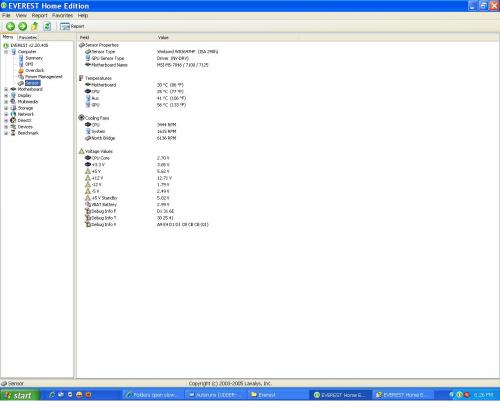Okay, here you go. I did find the DEBUG Line so I removed all of the info after that as you requested. I have attached the Autorun txt file and here are the others:
--------[ EVEREST Home Edition © 2003-2005 Lavalys, Inc. ]------------------------------------------------------------
Version EVEREST v2.20.405
Homepage
http://www.lavalys.com/ Report Type Quick Report
Computer UDDER-LIBBY-DAN
Generator Libby
Operating System Microsoft Windows XP Professional 5.1.2600 (WinXP Retail)
Date 2010-05-06
Time 18:19
--------[ Summary ]-----------------------------------------------------------------------------------------------------
Computer:
Operating System Microsoft Windows XP Professional
OS Service Pack Service Pack 3
DirectX 4.09.00.0904 (DirectX 9.0c)
Computer Name UDDER-LIBBY-DAN
User Name Libby
Motherboard:
CPU Type AMD Athlon 64, 2200 MHz (11 x 200)
Motherboard Name MSI K8N Neo4 Series (MS-7125) (4 PCI, 1 PCI-E x1, 1 PCI-E x4, 1 PCI-E x16, 4 DDR DIMM, Audio, Gigabit LAN)
Motherboard Chipset nVIDIA nForce4, AMD Hammer
System Memory 1536 MB (PC3200 DDR SDRAM)
BIOS Type Award (02/09/06)
Communication Port Communications Port (COM1)
Communication Port Printer Port (LPT1)
Display:
Video Adapter NVIDIA GeForce 7300 GS (512 MB)
3D Accelerator nVIDIA G72
Monitor Plug and Play Monitor [NoDB] (023500000001)
Multimedia:
Audio Adapter Creative Audigy LS Audio Processor
Storage:
IDE Controller NVIDIA nForce4 Parallel ATA Controller
SCSI/RAID Controller A7L6DPFM IDE Controller
SCSI/RAID Controller NVIDIA nForce™ RAID Class Controller
SCSI/RAID Controller NVIDIA nForce4 Serial ATA RAID Controller
SCSI/RAID Controller NVIDIA nForce4 Serial ATA RAID Controller
SCSI/RAID Controller WDC WD1600AAJS-60PSA0
SCSI/RAID Controller WDC WD1600AAJS-60PSA0
Floppy Drive Floppy disk drive
Disk Drive NVIDIA STRIPE 298.10G (298 GB)
Optical Drive HL-DT-ST CD-ROM GCR-8523B (52x CD-ROM)
Optical Drive KXSJA AFWDA7KT23S SCSI CdRom Device
Optical Drive LITE-ON COMBO SOHC-5236V (DVD:16x, CD:52x/32x/52x DVD-ROM/CD-RW)
Optical Drive PHILIPS SPD2413P
SMART Hard Disks Status Unknown
Partitions:
C: (NTFS) 305242 MB (277770 MB free)
Input:
Keyboard PS/2 Keyboard
Mouse PS/2 Compatible Mouse
Network:
Network Adapter Realtek RTL8139 Family PCI Fast Ethernet NIC (192.168.2.181)
Peripherals:
Printer HP LaserJet 4000 Series PS
Printer Microsoft XPS Document Writer
USB1 Controller nVIDIA MCP04 - OHCI USB Controller
USB2 Controller nVIDIA MCP04 - EHCI USB 2.0 Controller

 AutoRuns.txt 115.96KB
240 downloads
AutoRuns.txt 115.96KB
240 downloads












 AutoRuns.txt 115.96KB
240 downloads
AutoRuns.txt 115.96KB
240 downloads











